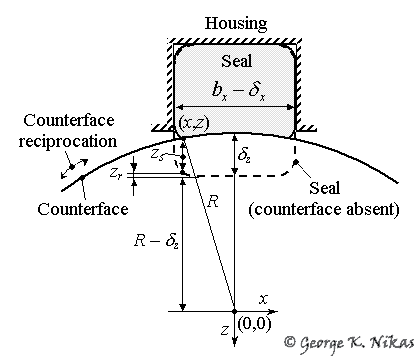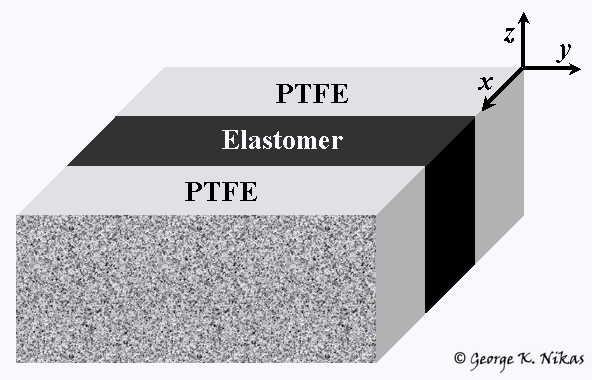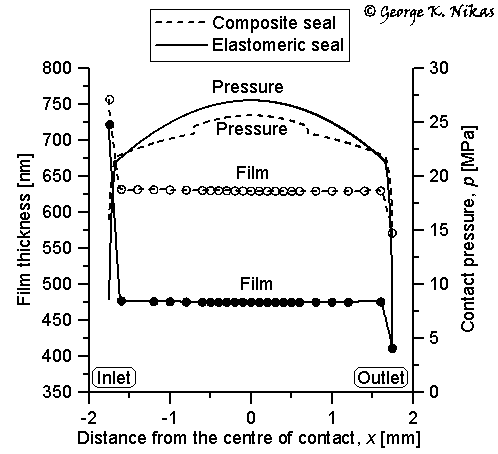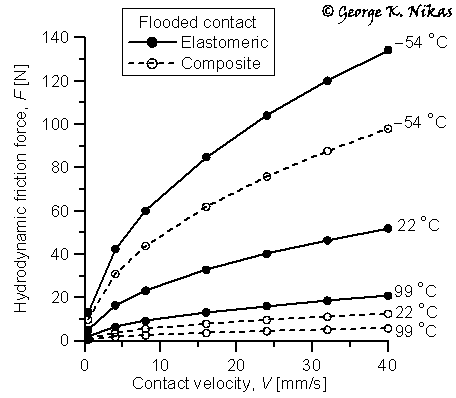
Paper: Modelling and optimization of composite rectangular reciprocating seals.
Authors: Nikas, G. K., Sayles, R. S.
Published
in: Proceedings of the
Institution of Mechanical Engineers, Part J: Journal of Engineering
Tribology, 2006, 220(4), 395-412
Abstract
A computational model of rectangular reciprocating seals, previously developed for elastomeric seals, has been extended to cover the mechanics and elastohydrodynamics of composite seals comprising two PTFE and one central elastomeric part, chemically bonded together. The model is demonstrated on a rotary vane actuator application and shown to produce realistic results regarding the contact pressure, film thickness, leakage, hydrodynamic friction force and seal extrusion. Total computational time is very short, typically up to five hundredths of a second (0.05 s) on a 1.5 GHz personal computer. The main purpose of the model is the analysis and optimization of said composite seal such that it outperforms the elastomeric seal (of exactly the same dimensions) in terms of leakage, hydrodynamic friction and extrusion in a wide range of operating conditions. For this goal, the PTFE-to-seal volume ratio of the composite seal is initially varied between zero and 90 per cent, and the results on leakage, hydrodynamic friction force, average film thickness in the sealing contact and extrusion length of the composite seal are plotted and compared with those of the elastomeric seal for nominal operating conditions at three temperatures (–54, +22 and +99 °C) and for both flooded and starved lubricating conditions in order to find a first approximant to the optimum PTFE-to-seal volume ratio that gives the composite seal better overall sealing performance. Then, using the selected approximant of the optimum ratio, a parametric study is performed to compute the effects of seal interference (proportional to contact pressure), contact velocity, seal corner radius and degree of lubricant starvation of the sealing contact on leakage, friction and seal extrusion at the previously mentioned three temperatures for both flooded and starved contacts, thus establishing the regions of operating conditions and design parameters that benefit one seal or the other. It was found that, overall, the composite seal, despite a small (insignificant) disadvantage on leakage, significantly outperformed the elastomeric seal in terms of hydrodynamic friction and extrusion. Further optimization is possible, depending on performance priorities (for example, if leakage is valued more than friction, or wear more than leakage, etc).
Some figures from this work
The seal configuration on which this study was conducted is shown in Fig. 1. The seal of rectangular cross-section seals a reciprocating counterface and liquid under pressure exists on the left or the right side of the seal (the system is symmetrical about the x = 0 plane). The dashed line represents the outline of the seal before the counterface is installed.

Fig. 1. Section of the seal assembly (exaggerated view).
The seal comprises an elastomeric and two PTFE (polytetrafluoroethylene) parts, as shown in Fig. 2.

Fig. 2. Configuration of composite seal.
The mechanics of the seal in operation are described by analytical equations in the article. The elastohydrodynamic lubrication problem of the seal for steady motion of the counterface is described by the Reynolds equation, which is solved for the film thickness at the seal-counterface interface, using the analytically derived contact pressure of the seal. An example of the contact pressure and related film thickness is shown in Fig. 3 for a composite seal as well as for an entirely elastomeric seal.

Fig. 3. Film thickness and contact pressure at -54 °C for flooded contact; for the composite seal, the PTFE volume is 60 per cent of the total seal volume.
By varying the PTFE-to-seal volume ratio in equidistant steps between zero and 100 per cent (where, obviously, zero corresponds to an entirely elastomeric seal and 100 per cent corresponds to a seal made entirely of PTFE), sealing performance diagrams have been obtained as explained in the abstract above; for example, such a diagram is shown in Fig. 4.

Fig. 4. An example from the article showing the hydrodynamic friction force versus the contact velocity; for the composite seal, the PTFE-to-seal volume ratio is 60 per cent (which is optimum).
The article contains 34 diagrams of six curves each on seal performance comparisons between the elastomeric and the composite seal. The study covers thoroughly the performance of both types of seal and shows the superiority of the composite seal in terms of hydrodynamic friction and resistance to extrusion, with a small (insignificant) disadvantage on leakage, provided PTFE-to-seal volume ratio is optimized (which is done in the article).
This study is based on a research project of the author.